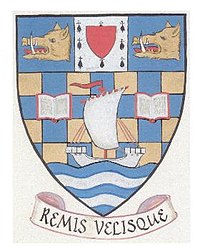Buckie High School
 |
|
| Motto |
Remis Velisque ("By, or with, oars and sails") |
|---|---|
| Established | 1874 |
| Type | Comprehensive state school |
| Rector | Neil Johnson |
| Location |
West Cathcart Street Buckie Banffshire AB56 1QB Scotland |
| Local authority | The Moray Council |
| Students | 903 (2008) |
| Gender | Co-educational |
| Ages | 11–18 |
| Houses | Cluny, Lennox, Rathburn, Seafield |
| Website | BCHS Website |
Buckie High School is a mixed secondary school in Buckie, Moray, Scotland which has a roll of around 900 pupils in years S1 to S6. The school serves the coastal communities of Portgordon, Buckie, Portessie, Findochty, Portknockie, and Cullen.
There has been a secondary school in Buckie since 1875. The opening followed the 1872 Education (Scotland) Act, which made education compulsory between the ages of 5 and 13 and put education in the charge of 895 school boards. Rathven School Board covered the Buckie area and built Buckie Public School in West Church Street, at its junction with Pringle Street. The first entry in the school’s log book on 14 January 1876 records that there were 100 pupils enrolled in the charge of a rector, and two pupil teachers. The curriculum consisted of reading, writing, arithmetic, grammar and composition, history, geography, singing and religious knowledge, with Latin for some pupils. The Latin in the school motto translates as 'with oars and sails' - and suggests doing things with all the effort and power one can muster.
School Board records show that by 1881 mathematics and domestic economy had been added to the curriculum and the roll had risen to 400, with a rector, two assistant teachers and six pupil teachers. In 1896, the school had nineteen staff and 850 pupils. The curriculum had been widened and now included Greek, French, cookery, industrial work, drawing, military drill, German, science and shorthand.
The first mention of national examinations was in 1894 when the school log in June noted that "the Leaving Certificate Examinations interfered with work", but in 1895 the Inspectors' report noted with commendation, "there were gained 53 Leaving Certificates – 18 at the Higher Grade."
For many years after 1876, school attendance followed a seasonal pattern depending on the herring fishing. At this time many families travelled with the fishing fleet as they followed the herring around the coast of Britain. In September 1880, for example, the school opened with 83 in attendance. In the next two weeks attendance rose to 183 and then 255, but by July it had dropped to 65. School log books refer to the herring fishing, lifting potatoes, pupils "jooking" and the problem of pupils "forgetting what they have been taught".
...
Wikipedia
